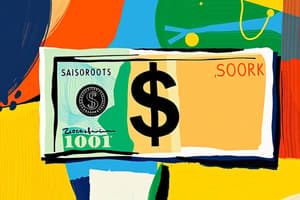Podcast
Questions and Answers
What are Blue-Chip Stocks?
What are Blue-Chip Stocks?
- Only common stocks
- High-risk stocks
- Stocks issued by small startups
- High-grade issues of major companies with a record of earnings (correct)
What are Growth Stocks?
What are Growth Stocks?
Issues of a company expanding faster than the economy and industry average
What defines a Defensive Stock?
What defines a Defensive Stock?
Issues that are resistant to a recession
What is an Income Stock?
What is an Income Stock?
What are Cyclical Stocks?
What are Cyclical Stocks?
What do American Depositary Receipts (ADRs) do?
What do American Depositary Receipts (ADRs) do?
What characterizes Preferred Stock?
What characterizes Preferred Stock?
What is Cumulative Preferred Stock?
What is Cumulative Preferred Stock?
What is Non-Cumulative Preferred Stock?
What is Non-Cumulative Preferred Stock?
What is Participating Preferred Stock?
What is Participating Preferred Stock?
What does Callable Preferred Stock allow companies to do?
What does Callable Preferred Stock allow companies to do?
What is Convertible Preferred Stock?
What is Convertible Preferred Stock?
What are Preemptive Rights?
What are Preemptive Rights?
What are Warrants?
What are Warrants?
What are Options in finance?
What are Options in finance?
Flashcards are hidden until you start studying
Study Notes
Stock Classifications
-
Blue-Chip Stocks: Represent major companies with a solid track record of steady earnings and consistent dividend payments. Considered low-risk investments.
-
Growth Stocks: Issued by companies experiencing rapid growth in sales, earnings, and market share, typically outperforming the broader economy and industry benchmarks.
-
Defensive Stocks: These stocks tend to maintain stable performance during economic downturns, often found in sectors like utilities and essential goods (e.g., pharmaceuticals, food).
-
Income Stocks: Known for providing higher-than-average dividends in relation to their stock price, appealing to investors seeking regular income.
-
Cyclical Stocks: Associated with companies whose earnings significantly rise and fall with the economic cycle, meaning performance is tied to economic conditions.
Stock Instruments
-
American Depositary Receipts (ADRs): Financial instruments that allow investors to trade foreign stocks on US exchanges, facilitating international investments.
-
Preferred Stock: A class of stock with no voting rights that guarantees a fixed dividend rate, representing the maximum return for preferred shareholders.
-
Cumulative Preferred Stock: Ensures that any unpaid dividends must be paid to preferred shareholders before common stockholders receive dividends.
-
Non-Cumulative Preferred Stock: Does not require companies to pay dividends in arrears, meaning missed dividend payments are lost to shareholders.
-
Participating Preferred Stock: Offers potential for higher dividends if the company performs well, especially when common dividends surpass a set threshold.
-
Callable Preferred Stock: Gives the issuing company the right to repurchase shares at a predetermined price in the future, providing strategic financial flexibility.
-
Convertible Preferred Stock: Combines fixed income with potential for capital appreciation, allowing holders to convert into common shares at a set price.
Rights and Options
-
Preemptive Rights: Rights granted to existing shareholders to purchase additional shares below market value, allowing them to maintain their ownership percentage during new issuance.
-
Warrants: Long-term instruments issued with preferred stocks or bonds, enabling holders to buy common shares at a set price above current market value.
-
Options: Contracts that provide the right to buy or sell an underlying asset within a specific timeframe, typically used for hedging, speculation, and income generation, with a term usually under nine months.
Studying That Suits You
Use AI to generate personalized quizzes and flashcards to suit your learning preferences.




